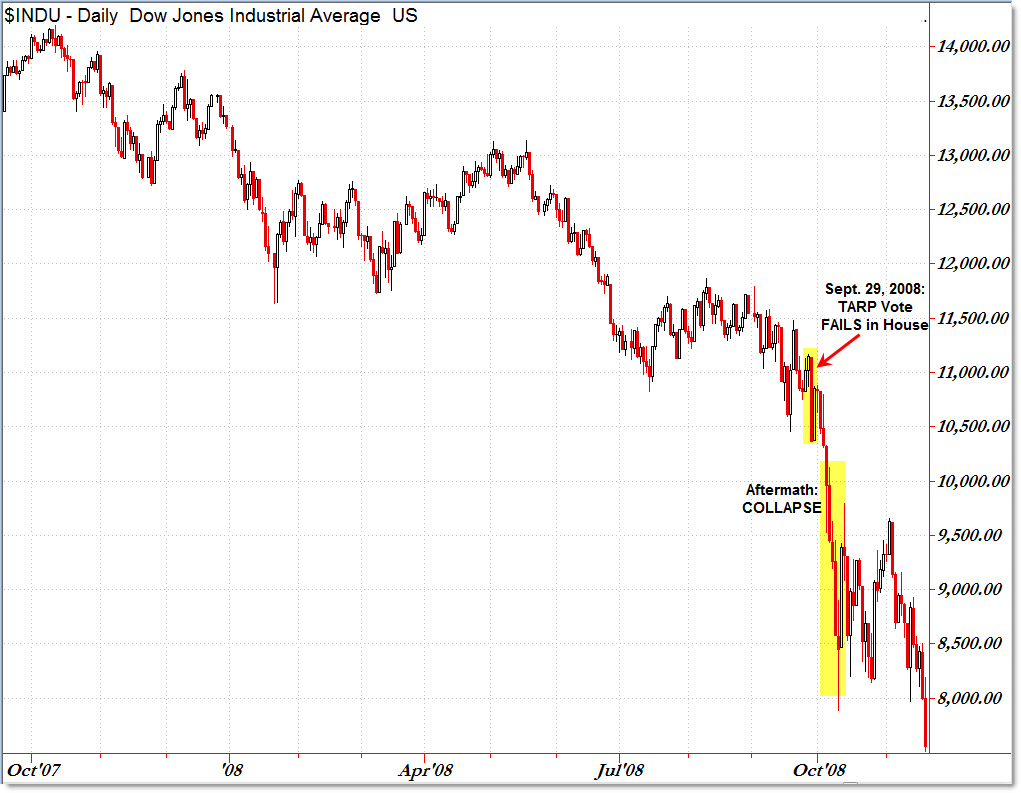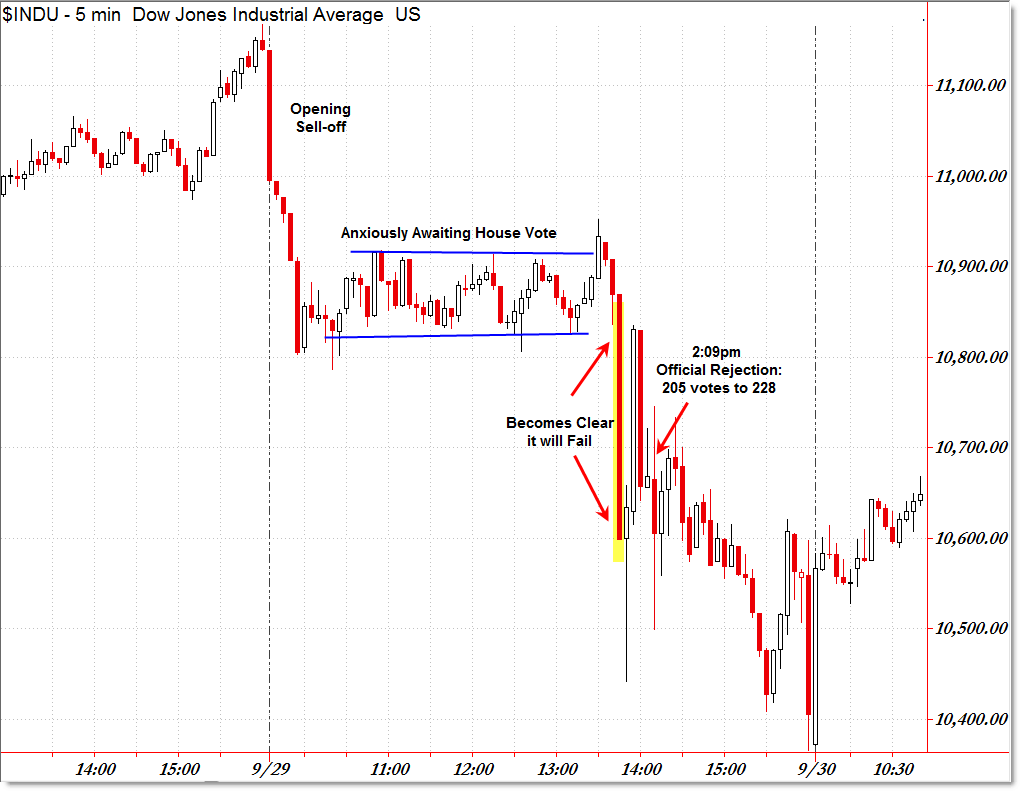Historical Insights from the TARP Bailout Vote Failure and the Market Crash in 2008
Traders of today can learn lessons from historical events where Politics and the Stock Market collided – with negative results.
Current Congressional gridlock is threatening another potential market crash via two separate but related events:
The US Debt Ceiling Negotiations ahead of August 2nd and the “Big Three” Credit Agencies warning that the US may receive a downgrade as a result of failed negotiations or a too small solution.
A full discussion of the current political and economical climate is outside the realm of this post, but I thought it would be helpful to study the most recent situation where Congressional gridlock helped usher in a literal stock market crash:
The initial TARP (Bail-out) Vote Failure and the 30% Decline in US Stocks over the next two weeks:

The chart above shows the stock market peak (Dow Jones) in October 2007 and the slow but steady downturn that resulted ahead of the October 2008 collapse.
Though there were certainly many negative headlines circling about during September and October 2008, I wanted to focus on the two votes for the initial (first) Bail-out Package – called “TARP” – and the aftermath that is currently being cited as a warning for what could happen again should Congress fail to pass a Debt Ceiling increase bill that the President will sign.
After a round of negotiations from then Treasury Secretary Henry Paulson and then President George W. Bush, the US House of Representatives voted on a controversial bail-out of financial institutions that was designed to stabilize the metastasizing financial crisis.
Notice that the stock market was in a relatively stable downtrend/decline until early October 2008.
After a contentious debate, the US House of Representatives – in what many thought was a must-pass ‘done deal,’ – rejected the initial TARP bail-out bill by a vote of 205 to 228.
Not only did this shock analysts and pundits, but it shocked the stock market as well, as it was assumed that this was a “must pass” bill that would be accepted.
It was not.
Here is a chart of the 5-min intraday structure on September 29th, 2008 when the vote failed at 2:09pm EST:

After an initial morning decline, the market (seen via the Dow Jones index) stagnated between 10,900 and 10,800 as debate continued in the US Congress.
C-SPAN carries debates live and offers live vote-counting coverage during the time the bill is open for Representatives to vote.
It became clear to pundits and observers that – despite initial expectations – the vote had taken a very negative turn before 2:00pm EST, and when voting closed at 2:09 EST, the measure was defeated.
This was the last time the stock market would see the 11,000 level until April 2010.
In 20 minutes during the live voting, the Dow Jones Index fell 500 points; from opening high to closing low, the Dow declined 740 points in a single session.
For traders, it was a nauseating nightmare ride to the downside and in the snap-back thrust on sentiment that “maybe the vote will pass after-all” as you can see in the 1-min chart below:

I added the typical indicators I use so that you can put yourself in the mindset of a trader during this day – observing TICK and momentum with the index, along with trendlines and a triangle price pattern that developed.
What most people forget is that there was a 350 violent dead-cat bounce for seven minutes after the initial plunge.
The optimism proved false as the official vote failed (see highlight) which further sent the market falling lower, compressing into a triangle, and then breaking lower for the remainder of the session.
With all the additional negative economic news afloat, the damage had been done – the markets were shaken, and when the dust later settled, the Dow Jones Index fell from 11,000 to 8,000 (a 30% plunge) by October 10th, 2008.
Congress eventually passed a near-identical TARP package on October 3rd (263 to 171) which was signed by President Bush within the hour.
Here is the complete set-up and aftermath of the two TARP votes during the 2008 Financial Crisis:

There are two key ironies that I learned from reviewing the charts and overlaying them with the Congressional Action:
1. The Stock Market actually crashed AFTER the TARP Bill was later signed into law.
2. The Stock Market was actually ‘FLAT’ between two TARP votes.
I’ve been hearing a lot about how “The Stock Market Crash from the first failed TARP vote immediately caused House Members to act and pass TARP on a second emergency vote.”
While the stock market fell on September 29th (first TARP vote), the actual crash ironically materialized AFTER President Bush signed the TARP bail-out package into law – beginning the turmoil on Monday October 6th.
Instead, the stock market was relatively flat between the first failed TARP vote on Monday, September 29th and the second successful vote on Friday, October 3rd.
One might logically assume the crash happened after the first failed TARP vote and then the market stabilized after the second successful TARP vote but that was not the case.
Many pundits and analysts today are using similar logic when regard to the Debt Ceiling, along the lines of:
“Maybe Congress needs another Stock Market Crash to get them to reach an agreement on the current Debt Ceiling Debate.”
I’m not going to speculate on what’s about to happen, or how the markets might react, but I thought it would be helpful to show what actually happened during the last time Congressional Gridlock helped contribute to a literal Stock Market Crash that spurred political action.
Many analysts/pundits are predicting another Stock Market crash if the Debt Ceiling is not raised by August 2nd, 2011.
If that is the case, then again I thought it would be helpful to see a historical reference of what the past 2008 crash looked like day-by-day.
Take time to study the charts, watch the news closely, and be prepared for some type of negative market reaction (that may be an understatement) should Congress fail to reach agreement, or if the “Big Three” credit agencies downgrade the United States even if a minor or emergency agreement is reached.
Corey Rosenbloom, CMT
Afraid to Trade.com
Follow Corey on Twitter: http://twitter.com/afraidtotrade
Corey’s new book The Complete Trading Course (Wiley Finance) is now available!

Interesting!
Very interesting post. Although there are a lot of similarities, there are a few things that are different. The market had topped out nearly a year earlier and was in a clear downtrend, which made the market especially vulnerable to bad news. The market has been rallying for 2 years now in the face of awful news, the market may be less suceptable to a crash since the trend is clearly up. It could be a flash crash type sell-off where we see an inital crash, and then price recovering to rally into new highs after some backing and filling.
This is very interesting, although I don't believe on the default talk. A default is totally different from the 08 bailout fundamentally. That is a lost in economic/financial leadership, considers that the U.S. treasury is the most liquid asset in the world economy, which is why we are calling it as the “risk free rate”. An U.S. default will change this role and change the whole financial modeling system. That is going to be a disaster for portfolio management and everything.
This caught my eye… really good post
Tarps are often designed as wind flow rights, though the companies do not assurance them for use in any type of climate. Therefore, you may not be able to advantage from the assurance in situation a more chaotic weather-related event happens and loss the poly tarp cover.